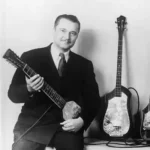
Adolph Rickenbacker – A Luminary of Electric Guitar
Table of Contents
Early Years
Born on April 1, 1886, in Basel, Switzerland, Adolph Rickenbacker’s real last name was originally spelled “Rickenbacher.” Along with his family, young Adolph emigrated to the United States, settling in Wisconsin. His family’s early days in America were marred with hardship, especially after the passing of his parents, leaving Adolph and his siblings to fend for themselves.
While he started as a draftsman and then an engineer in Los Angeles, Adolph’s trajectory dramatically shifted when he met George Beauchamp, a vaudeville musician. Beauchamp was in pursuit of an amplified guitar sound, a quest rooted in the desire to have the guitar audible over the loud bands of the era.
The Electric Guitar Revolution
Together with Beauchamp and Paul Barth, Rickenbacker founded the Ro-Pat-In Corporation in 1931. The company’s primary goal was to design and manufacture electric guitars. Their earliest models, made of aluminum and nicknamed “Frying Pans” due to their circular body and long neck, are considered some of the first electric guitars ever made. By 1934, the company had rebranded as the Electro String Instrument Corporation but kept using the Rickenbacker name on their products, given Adolph’s engineering prowess and growing reputation.
Business Ventures and World War II
Apart from his contributions to the music world, Adolph was also an astute businessman. He founded the Rickenbacker Company, which, during World War II, contributed to the war effort by producing aluminum and plastic parts for the aviation industry. This experience would later influence guitar designs, notably the use of Bakelite – an early type of plastic.
Later Years and Legacy
Over the years, Rickenbacker’s electric guitars gained significant popularity, especially in the 1960s. Bands like The Beatles had George Harrison sporting a Rickenbacker, cementing its iconic status.
Adolph Rickenbacker sold his company in 1953 but his legacy as a pioneer in electric guitar manufacturing was already well established.
He passed away on March 21, 1976, in Orange County, California.
